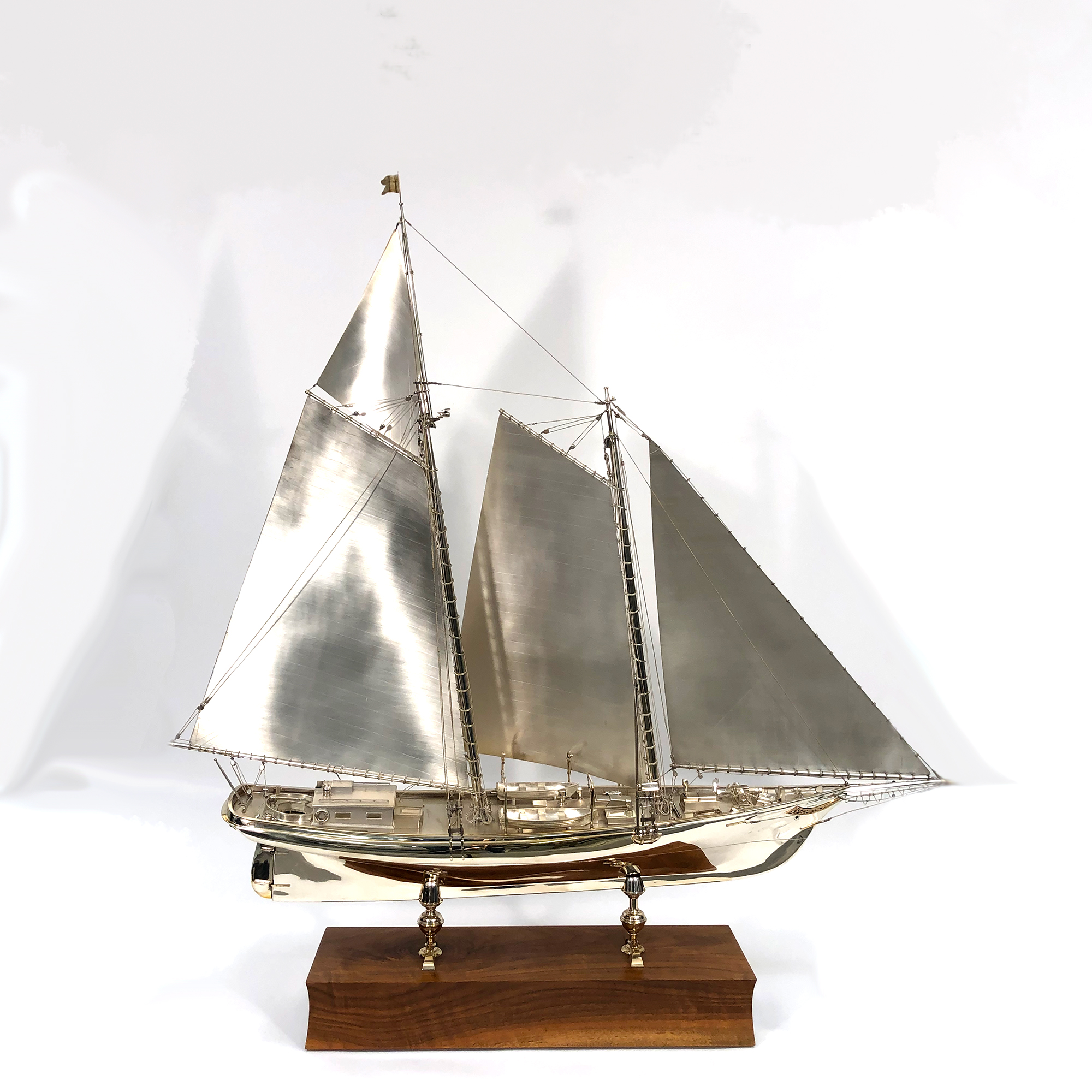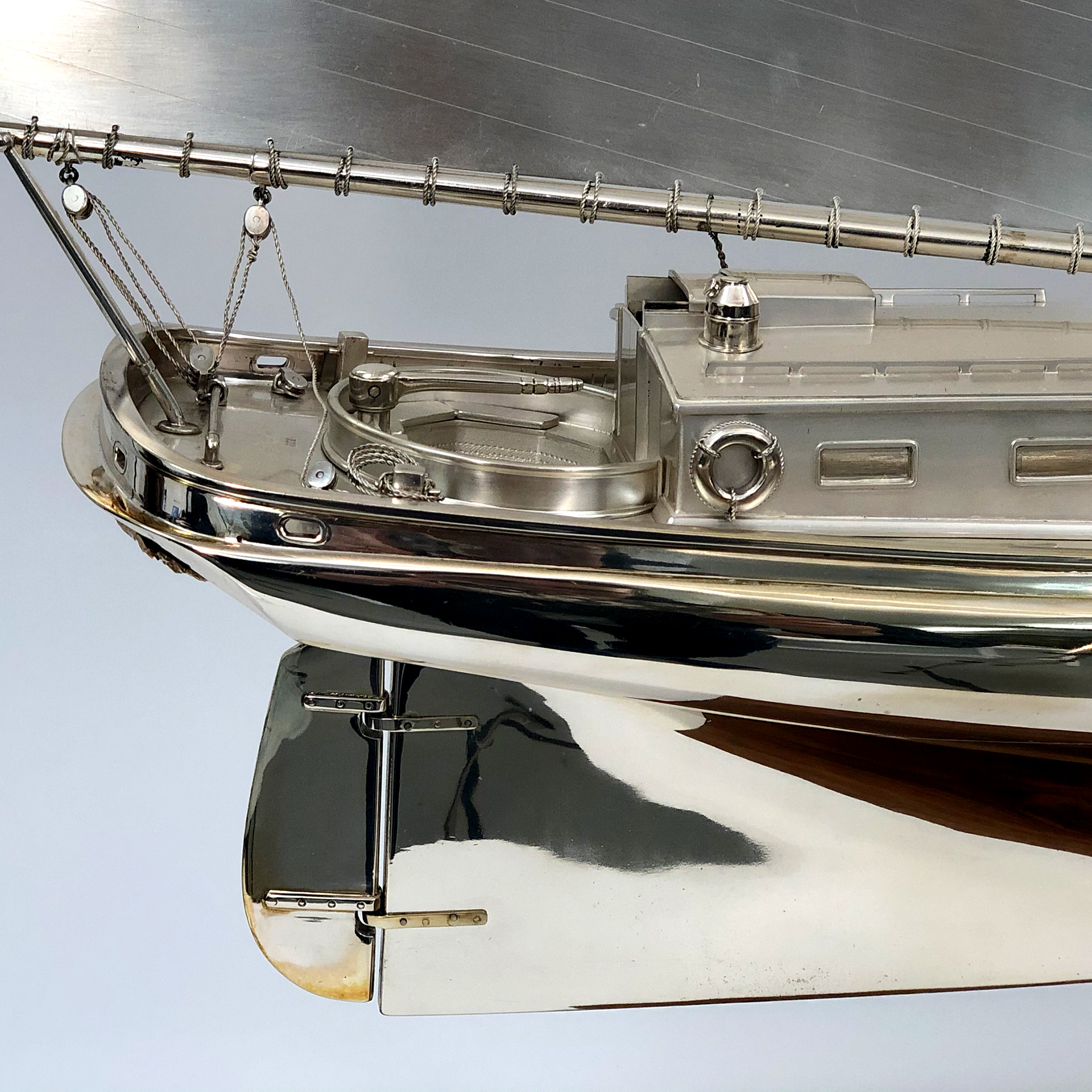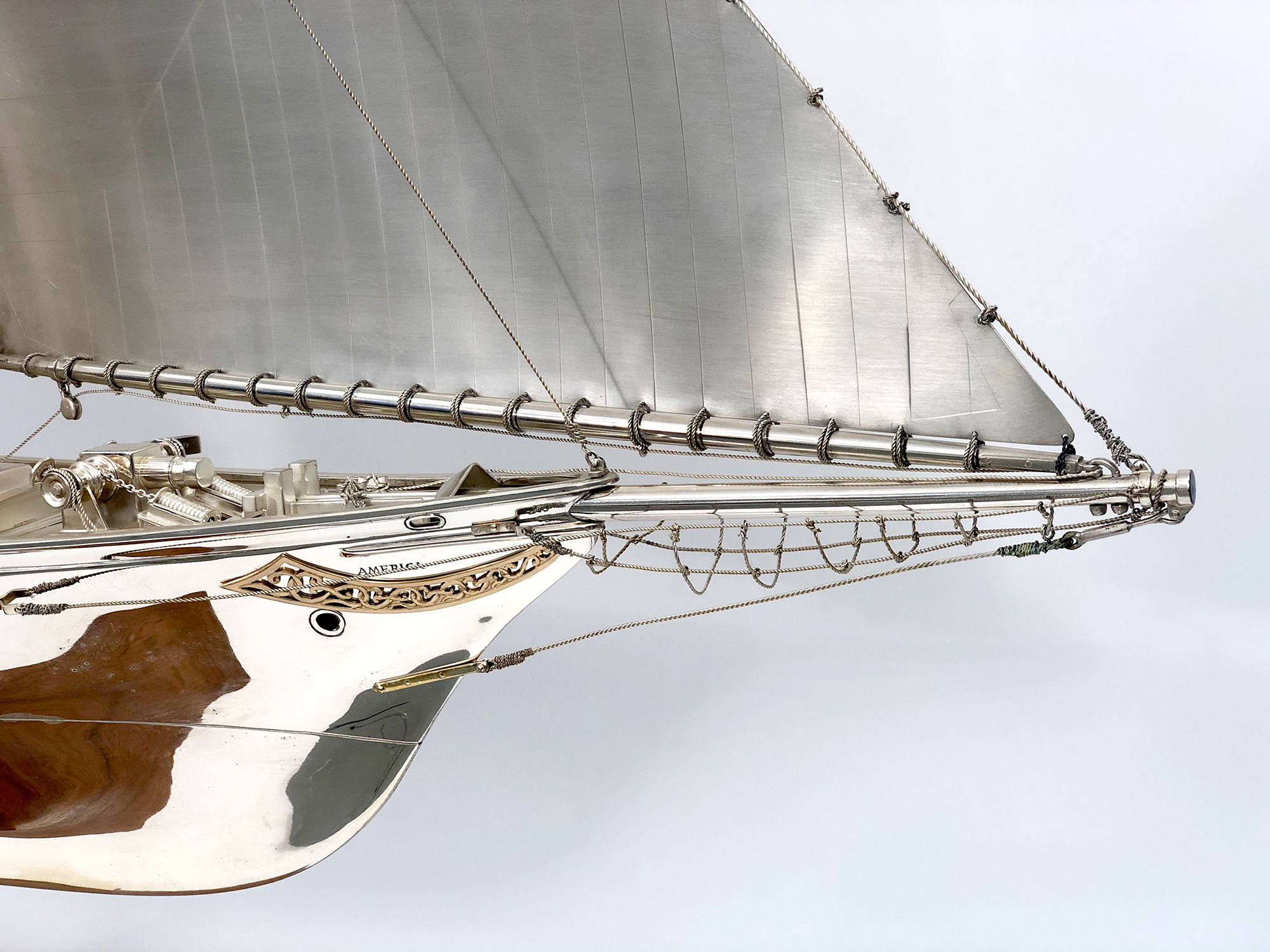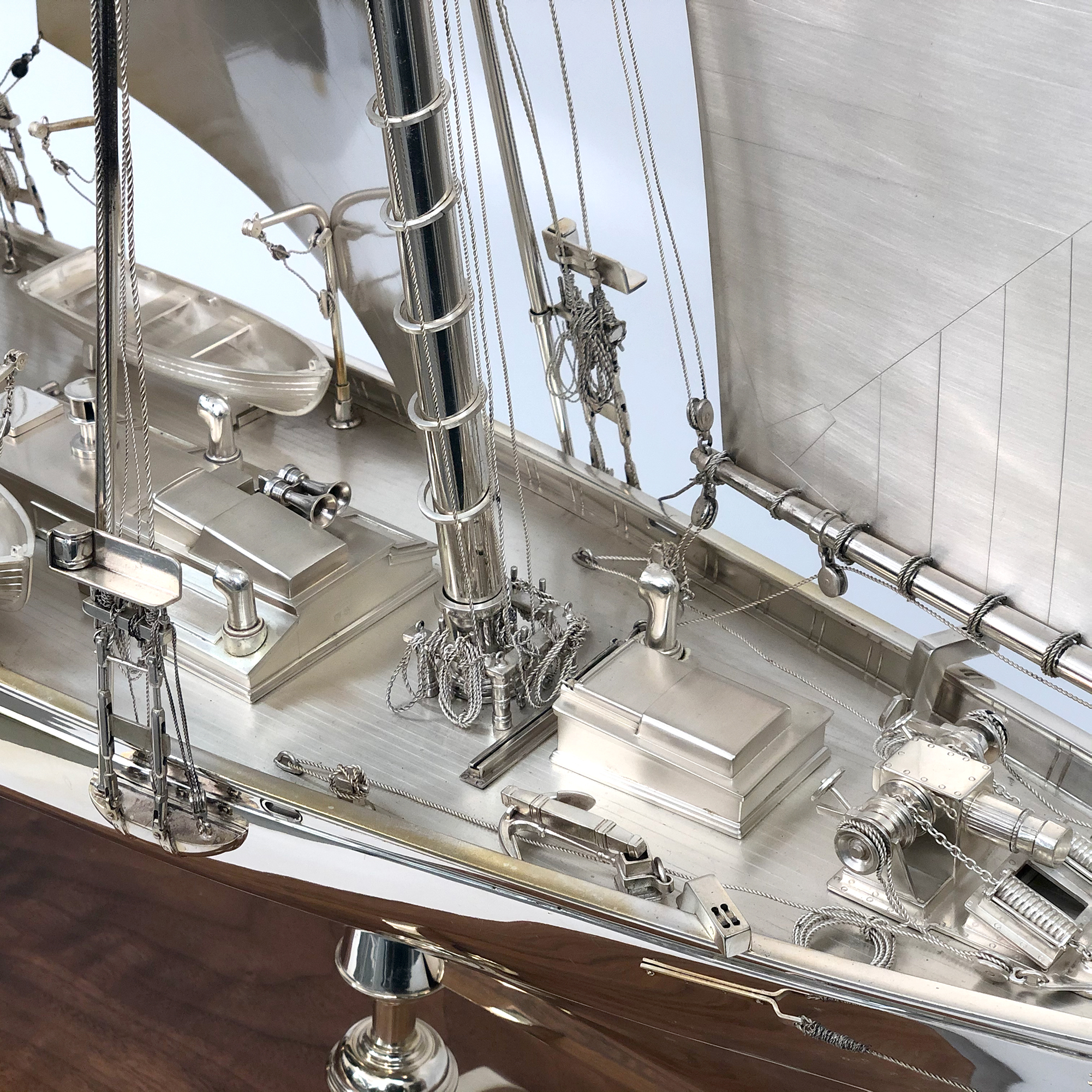The America II Model Ship
By Amanda Wastrom, Curator
 Every exhibit needs a showstopper. That attention-grabbing thing that stops visitors in their tracks and (ideally) inspires gasps of awe and astonishment. That’s the dream of every curator after all: lots of pointing, closer looking, and exclamations of wow! and isn’t that amazing! when anyone wanders into the gallery. We want everyone to find the museum’s objects as fascinating as we do!
Every exhibit needs a showstopper. That attention-grabbing thing that stops visitors in their tracks and (ideally) inspires gasps of awe and astonishment. That’s the dream of every curator after all: lots of pointing, closer looking, and exclamations of wow! and isn’t that amazing! when anyone wanders into the gallery. We want everyone to find the museum’s objects as fascinating as we do!
Fortunately, Heritage has quite a few objects that fit the bill. The 1930 Duesenberg and the Charles I.D. Looff Carousel, the hydrangeas, the Flume, and the Fringe Tree in bloom are just a few of many things at Heritage that inspire joy and plenty of ‘wows’ from visitors.
In mounting this year’s Heritage Highlights exhibit in the American Art & Carousel Gallery, I tried to pick as many Heritage showstopper pieces as I could. One of my favorites is the silver ship model of the America II. As with many of Heritage’s finest treasures, it is visually stunning. It is a celebration of human craftsmanship— just look what we can do with silver! Why would we make something like this? Because we can! It’s a completely joyous, completely frivolous, completely human thing to do. Not to mention, a flamboyant display of wealth. The America II also has two bonus fun factors: it’s blindingly sparkly and it’s a perfect scale-miniature. Look at those coils of rope! And the miniature rowboats!
Beyond the bling and the tiny details, this piece has multiple fun stories to tell. There is the story of its making. And then there is the story of the original America yacht—arguably the most storied yacht in recent history—for which the America II was built as a replica. So this object is a model of a copy of a legendary ship. Did you keep that all straight? Let’s unpack some of those stories!
The Yacht America and the first America’s Cup
The story of the America begins with a challenge. While the origins of the challenge are uncertain, in the 1850s, there was a wager thrown out that no American yacht could beat a British one in a race. When members of the New York Yacht Club caught wind of this, they decided to act on the challenge and hired boat designers (and brothers) James Rich Steers and George Steers to create the fastest yacht possible. The result was the America, which was subsequently launched in New York in 1851. She sailed across the Atlantic to face off against any British yacht willing to take her on. In a regatta of the Royal Yacht Squadron–a 53-mile race around the Isle of Wight that was attended by Queen Victoria (an avid yachtswoman herself)–the America won handily, beating a field of fifteen other British yachts. The next closest yacht, the Aurora, came in about 18 minutes behind.
Some say the win was due to a technicality where the America essentially took a shortcut near an area called Nab Rocks by slipping between a lightship and the mainland (the race rules were unclear on the route and on which side of the lightship yachts were supposed to sail). Regardless, the results stand and the America has gone down in history for its success. The race was named The America’s Cup, in honor of that yacht, and has become the penultimate prize in sailing. It is also the oldest international sporting competition. The America went on to have quite a life of its own (plenty more stories there to share), but was eventually left to rot and decay in a boat shed and was destroyed when the barn collapsed during a snowstorm in the 1940s.
Several replicas have been made of the America over the years, but the first was the America II, built by Goudy & Stevens Shipyard in Boothbay, Maine, and launched in 1967. She was built for Rudolph Schaefer, Jr., owner of F. & M. Schaefer Brewing Co.
A model to commemorate a legend
The America II ship model was custom ordered by J.K. Lilly III, one of Heritage’s founders. It was designed and made by Sidney Sparrow, who worked for an esteemed London silver company called William Comyns & Sons, Ltd. By all accounts, Sparrow was truly a master of his craft. In a letter to Heritage’s curator in the 1970s, Donald C. Thomas, of Shreve, Crump & Low Co. in Boston described Mr. Sparrow as “the greatest craftsman that I know…He is a most remarkable and probably the most modest man I ever met in my life. To say he is a genius is an understatement.” From its sails to its rigging, winches, and rudder, this incredible piece is made entirely of sterling silver at a scale of 1 inch to 3 feet. At 47 inches high and about 45 inches wide, its size is a feat in itself. Mr. Lilly noted that it took years for the piece to be completed.
The punchline to this whole story is that when the silver ship model finally arrived, it was a model of the wrong ship! Mr. Lilly had requested a model of the original America. Somehow, that message was lost in translation, and Mr. Sparrow, the silversmith, made a model of the America II instead. “You have no idea of the consternation that occurred when the model arrived from the silversmith, after two or three years of waiting, and we discovered that we had not received what we had ordered,” said Mr. Lilly, reflecting back on the incident in a letter. “However, after much discussion, it was decided to keep what we had received and display it. The feeling was that since it very definitely relates to the first America, it still illustrates the craftsmanship of yacht building in our country.” If you look closely, you can find features such as a radar and electronic components that simply wouldn’t have been on the original America yacht. But aside from those, the America II model is a faithful duplicate of the first America.
All stories aside, the America II stuns me every time I see it. The astounding craftsmanship of the model seems an appropriate tribute to the ground-breaking yacht design that secured the first America its place in yachting lore. Ready to come see it yourself? It’s currently on exhibit in the American Art & Carousel Gallery and will be on display through the end of the season.











